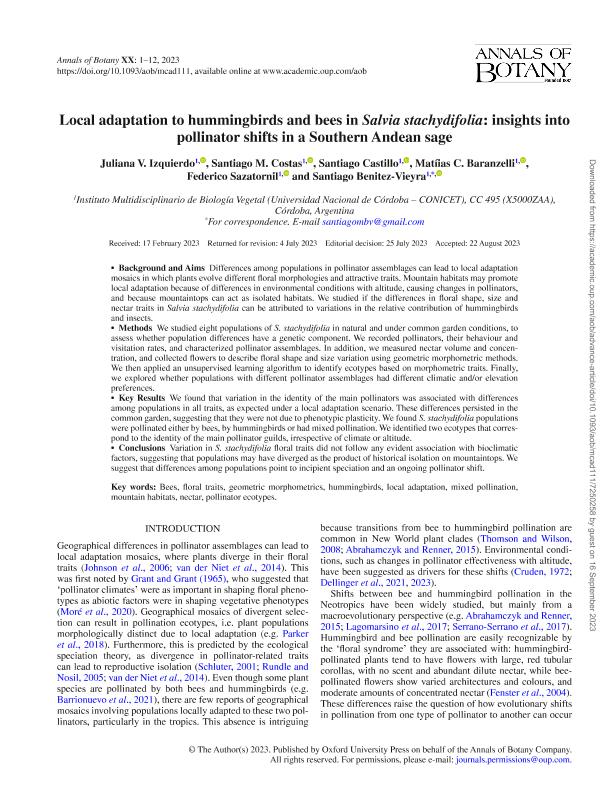Artículo
Local adaptation to hummingbirds and bees in Salvia stachydifolia : insights into pollinator shifts in a Southern Andean sage
Izquierdo, Juliana Verónica ; Costas, Santiago
; Costas, Santiago ; Castillo, Santiago
; Castillo, Santiago ; Baranzelli, Matias Cristian
; Baranzelli, Matias Cristian ; Sazatornil, Federico David
; Sazatornil, Federico David ; Benitez Vieyra, Santiago Miguel
; Benitez Vieyra, Santiago Miguel
 ; Costas, Santiago
; Costas, Santiago ; Castillo, Santiago
; Castillo, Santiago ; Baranzelli, Matias Cristian
; Baranzelli, Matias Cristian ; Sazatornil, Federico David
; Sazatornil, Federico David ; Benitez Vieyra, Santiago Miguel
; Benitez Vieyra, Santiago Miguel
Fecha de publicación:
24/08/2023
Editorial:
Oxford University Press
Revista:
Annals of Botany
ISSN:
0305-7364
e-ISSN:
1095-8290
Idioma:
Inglés
Tipo de recurso:
Artículo publicado
Clasificación temática:
Resumen
Differences among populations in pollinator assemblages can lead to local adaptation mosaics in which plants evolve different floral morphologies and attractive traits. Mountain habitats may promote local adaptation because of differences in environmental conditions with altitude, causing changes in pollinators, and because mountaintops can act as isolated habitats. We studied if the differences in floral shape, size and nectar traits in Salvia stachydifolia can be attributed to variations in the relative contribution of hummingbirds and insects.• Methods We studied eight populations of S. stachydifolia in natural and under common garden conditions, to assess whether population differences have a genetic component. We recorded pollinators, their behaviour and visitation rates, and characterized pollinator assemblages. In addition, we measured nectar volume and concentration, and collected flowers to describe floral shape and size variation using geometric morphometric methods. We then applied an unsupervised learning algorithm to identify ecotypes based on morphometric traits. Finally, we explored whether populations with different pollinator assemblages had different climatic and/or elevationpreferences.• Key Results We found that variation in the identity of the main pollinators was associated with differences among populations in all traits, as expected under a local adaptation scenario. These differences persisted in the common garden, suggesting that they were not due to phenotypic plasticity. We found S. stachydifolia populations were pollinated either by bees, by hummingbirds or had mixed pollination. We identified two ecotypes that correspond to the identity of the main pollinator guilds, irrespective of climate or altitude.• Conclusions Variation in S. stachydifolia floral traits did not follow any evident association with bioclimatic factors, suggesting that populations may have diverged as the product of historical isolation on mountaintops. We suggest that differences among populations point to incipient speciation and an ongoing pollinator shift.
Archivos asociados
Licencia
Identificadores
Colecciones
Articulos(IMBIV)
Articulos de INST.MULTIDISCIPL.DE BIOLOGIA VEGETAL (P)
Articulos de INST.MULTIDISCIPL.DE BIOLOGIA VEGETAL (P)
Citación
Izquierdo, Juliana Verónica; Costas, Santiago; Castillo, Santiago; Baranzelli, Matias Cristian; Sazatornil, Federico David; et al.; Local adaptation to hummingbirds and bees in Salvia stachydifolia : insights into pollinator shifts in a Southern Andean sage; Oxford University Press; Annals of Botany; XX; 24-8-2023; 1-12
Compartir
Altmétricas



